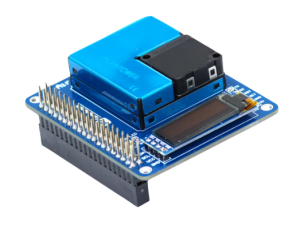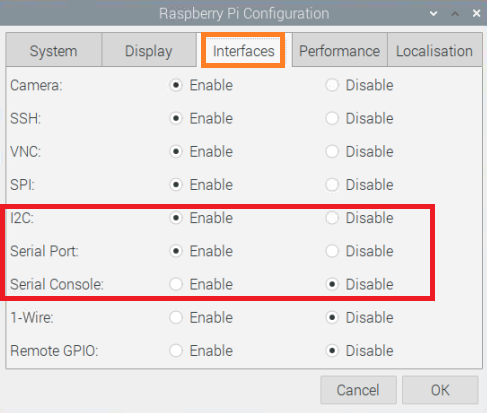Difference between revisions of "Pi-Finger"
From SB-Components Wiki
(Replaced content with "== PiFinger ==") Tag: Replaced |
|||
| Line 1: | Line 1: | ||
| − | == PiFinger == | + | <div class="row"> |
| + | <div class="large-8 column"> | ||
| + | == Pi-FInger == | ||
| + | nents. PiFinger, the first-ever Fingerprint HAT for Raspberry Pi Comprise of onboard Nuvoton MCU with an on-chip crypto-accelerator, Cortex-M23 TrustZone, and XOM facilities. A user can use the communication protocol to the PiFinger with commands over the UART protocol with the Baud rate 115200 bps or USB 2.0 full speed. | ||
| + | |||
| + | === Features === | ||
| + | * Capacitive Contact Technology | ||
| + | * On Chip-Crypto Accelerator | ||
| + | * High-Speed UART Interface | ||
| + | * Register up to 24 Fingerprints | ||
| + | * Nuvoton MCU | ||
| + | *Cortex-M23 Trust zone | ||
| + | |||
| + | === Specifications === | ||
| + | * Processor - Nuvoton MCU Cortex M23 | ||
| + | * Communication - UART, USB 2.0 and GPIO | ||
| + | * Display - 0.91” OLED (SSD1306) | ||
| + | * Buzzer - Yes | ||
| + | * Default Baud Rate - 9600 bps | ||
| + | * Matching Mode - 1:1,1:N | ||
| + | |||
| + | </div> | ||
| + | <div class="large-4 column"> | ||
| + | [[File:Air_Monitoring_HAT.png|thumb|left|alt=Air Monitoring HAT| Buy it From : ''[https://shop.sb-components.co.uk/products/air-monitoring-hat-for-raspberry-pi Click Here]'']] | ||
| + | </div> | ||
| + | </div> | ||
| + | |||
| + | == Pinout == | ||
| + | <table class="wikitable"> | ||
| + | <tr> <th> PiFinger </th> <th>Raspberry Pi</th> </tr> | ||
| + | <tr><td> VCC </td> <td> 5V </td> </tr> | ||
| + | <tr><td> GND </td> <td> GND </td> </tr> | ||
| + | <tr><td> Fingerprint TX </td> <td> GPIO15 (RXD) </td> </tr> | ||
| + | <tr><td> Fingerprint RX </td> <td> GPIO14 (TXD) </td> </tr> | ||
| + | <tr><td> OLED SDA </td> <td> GPIO2 (SDA) </td> </tr> | ||
| + | <tr><td> OLED SCL </td> <td> GPIO3 (SCL) </td> </tr> | ||
| + | <tr><td> BUZZER </td> <td> GPIO13 </td> </tr> | ||
| + | |||
| + | </table> | ||
| + | |||
| + | == Installation == | ||
| + | ==== Python ==== | ||
| + | ===== Required Hardware ===== | ||
| + | * Raspberry Pi x 1 | ||
| + | * Pi-Finger x 1 | ||
| + | |||
| + | ===== Enable I2C and Serial Interface ===== | ||
| + | * Open a terminal and run the following commands to enable I2C: | ||
| + | <source lang="shell"> sudo raspi-config </source> | ||
| + | |||
| + | Choose Interfacing Options -> I2C ->yes | ||
| + | |||
| + | * Again run below command to enable Serial | ||
| + | <source lang="shell"> sudo raspi-config </source> | ||
| + | Choose Interfacing Options -> Serial -> No -> Yes | ||
| + | |||
| + | * You can also enable Serial and I2C using Graphical method, Open Menu by clicking on <b> Raspberry Pi icon >> Preferences >> Raspberry Pi Configurations >> Interfaces </b>, and select below option. | ||
| + | |||
| + | [[File:Serial_i2c_en_graphical.PNG]] | ||
| + | |||
| + | * Now reboot your pi by running the below command : | ||
| + | <source lang="shell"> sudo reboot </source> | ||
| + | |||
| + | ===== <b> Board Test </b> ===== | ||
| + | * Connect PiFinger on top of 40 pins stackable GPIO header of Raspberry Pi. | ||
| + | |||
| + | * Now Clone/Download PiFinger Repository by running below command or directly download from Github. | ||
| + | |||
| + | <source lang="shell"> git clone https://github.com/sbcshop/PiFinger.git </source> | ||
| + | |||
| + | * Open cloned/downloaded folder and choose your environment type (i.e: Raspberry Pi or Windows) | ||
| + | |||
| + | ''' For Raspberry Pi ''' | ||
| + | |||
| + | * Run PiFinger GUI by running the below command: | ||
| + | <source lang="shell" inline>python3 PiFinger_GUI.py </source> or using any python3 supported ide. | ||
| + | |||
| + | Select COM port and Baud Rate ( default is 9600) from the above GUI ("/dev/ttyS0" in case of default connection), and click on connect button to start communication with the fingerprint sensor. | ||
| + | |||
| + | |||
| + | == Resources == | ||
| + | |||
| + | ''' Github ''' | ||
| + | |||
| + | * [https://github.com/sbcshop/Air-Monitoring-HAT Source Code] | ||
| + | |||
| + | ''' Datasheet ''' | ||
| + | |||
| + | * [https://cdn.shopify.com/s/files/1/1217/2104/files/PMSA003_datasheet.pdf PMSA003 Datasheet] | ||
Revision as of 05:12, 23 June 2021
Pi-FInger
nents. PiFinger, the first-ever Fingerprint HAT for Raspberry Pi Comprise of onboard Nuvoton MCU with an on-chip crypto-accelerator, Cortex-M23 TrustZone, and XOM facilities. A user can use the communication protocol to the PiFinger with commands over the UART protocol with the Baud rate 115200 bps or USB 2.0 full speed.
Features
- Capacitive Contact Technology
- On Chip-Crypto Accelerator
- High-Speed UART Interface
- Register up to 24 Fingerprints
- Nuvoton MCU
- Cortex-M23 Trust zone
Specifications
- Processor - Nuvoton MCU Cortex M23
- Communication - UART, USB 2.0 and GPIO
- Display - 0.91” OLED (SSD1306)
- Buzzer - Yes
- Default Baud Rate - 9600 bps
- Matching Mode - 1:1,1:N

Buy it From : Click Here
Pinout
| PiFinger | Raspberry Pi |
|---|---|
| VCC | 5V |
| GND | GND |
| Fingerprint TX | GPIO15 (RXD) |
| Fingerprint RX | GPIO14 (TXD) |
| OLED SDA | GPIO2 (SDA) |
| OLED SCL | GPIO3 (SCL) |
| BUZZER | GPIO13 |
Installation
Python
Required Hardware
- Raspberry Pi x 1
- Pi-Finger x 1
Enable I2C and Serial Interface
- Open a terminal and run the following commands to enable I2C:
sudo raspi-config
Choose Interfacing Options -> I2C ->yes
- Again run below command to enable Serial
sudo raspi-config
Choose Interfacing Options -> Serial -> No -> Yes
- You can also enable Serial and I2C using Graphical method, Open Menu by clicking on Raspberry Pi icon >> Preferences >> Raspberry Pi Configurations >> Interfaces , and select below option.
- Now reboot your pi by running the below command :
sudo reboot
Board Test
- Connect PiFinger on top of 40 pins stackable GPIO header of Raspberry Pi.
- Now Clone/Download PiFinger Repository by running below command or directly download from Github.
git clone https://github.com/sbcshop/PiFinger.git
- Open cloned/downloaded folder and choose your environment type (i.e: Raspberry Pi or Windows)
For Raspberry Pi
- Run PiFinger GUI by running the below command:
python3 PiFinger_GUI.py or using any python3 supported ide.
Select COM port and Baud Rate ( default is 9600) from the above GUI ("/dev/ttyS0" in case of default connection), and click on connect button to start communication with the fingerprint sensor.
Resources
Github
Datasheet

